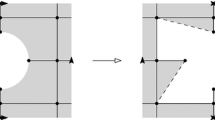Abstract
In a previous paper [3], we showed how certain orientations of the edges of a graph Γ embedded in a closed oriented surface Σ can be understood as discrete spin structures on Σ. We then used this correspondence to give a geometric proof of the Pfaffian formula for the partition function of the dimer model on Γ. In the present article, we generalize these results to the case of compact oriented surfaces with boundary. We also show how the operations of cutting and gluing act on discrete spin structures and how they change the partition function. These operations allow to reformulate the dimer model as a quantum field theory on surface graphs.
Similar content being viewed by others
References
Álvarez-Gaumé L., Bost J.-B., Moore G., Nelson P. and Vafa C. (1987). Bosonization on higher genus Riemann surfaces. Commun. Math. Phys. 112: 503–552
Atiyah M. (1988). Topological quantum field theories. Inst. Hautes Études Sci. Publ. Math. 68: 175–186
Cimasoni D. and Reshetikhin N. (2007). Dimers on surface graphs and spin structures. I. Commun. Math. Phys. 275: 187–208
Cohn H., Kenyon R. and Propp J. (2001). A variational principle for domino tilings. J. Amer. Math. Soc. 14: 297–346
Johnson D. (1980). Spin structures and quadratic forms on surfaces. J. London Math. Soc. (2) 22: 365–373
Kasteleyn W. (1963). Dimer statistics and phase transitions. J. Math. Phys. 4: 287–293
Kasteleyn, W.: Graph Theory and Theoretical Physics. London: Academic Press, 1967, pp. 43–110
Kenyon R. and Okounkov A. (2006). Planar dimers and Harnack curves. Duke Math. J. 131: 499–524
Kenyon R., Okounkov A. and Sheffield S. (2006). Dimers and amoebae. Ann. of Math. (2) 163: 1019–1056
Kuperberg, G.: An exploration of the permanent-determinant method. Electron. J. Combin. 5, Research Paper 46, (1998) 34 pp. (electronic)
Galluccio, A., Loebl, M.: On the theory of Pfaffian orientations. I. Perfect matchings and permanents. Electron. J. Combin. 6, Cambridge MA: Research Paper 6, (1999) 18 pp. (electronic)
McCoy, B., Wu, T.T.: The two-dimensional Ising model. Cambridge MA: Harvard University Press, 1973
Segal, G.: The definition of conformal field theory. In: Differential geometrical methods in theoretical physics (Como, 1987), NATO Adv. Sci. Inst. Ser. C Math. Phys. Sci., 250, Dordrecht: Kluwer Acad. Publ., 1988, pp. 165–171
Tesler G. (2000). Matchings in graphs on non-orientable surfaces, J. Combin. Theory Ser. B 78(2): 198–231
Author information
Authors and Affiliations
Corresponding author
Additional information
Communicated by L. Takhtajan
Rights and permissions
About this article
Cite this article
Cimasoni, D., Reshetikhin, N. Dimers on Surface Graphs and Spin Structures. II. Commun. Math. Phys. 281, 445–468 (2008). https://doi.org/10.1007/s00220-008-0488-3
Received:
Accepted:
Published:
Issue Date:
DOI: https://doi.org/10.1007/s00220-008-0488-3



